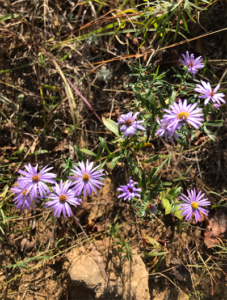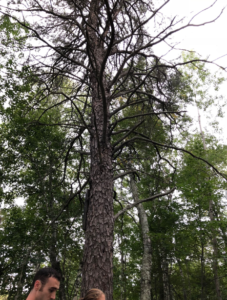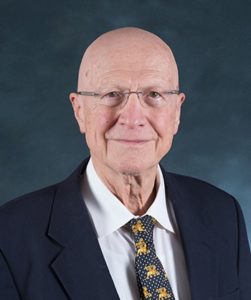Saint Mary's Newsroom
Campus ConnectionAn update from the president to alumni and parents
Halberg, Sonday, and Boeve interviewed on Cardinals’ Nest [video]
Jeff Halberg, head men’s and women’s tennis coach, and Julia Boeve and Laura Sonday, senior tennis players, were recently featured in an episode of Cardinals’ Nest, a TV program that airs on Winona cable access HBC TV-25. Cardinals’ Nest is cohosted by Donny Nadeau, sports information director, and Dean Beckman, Communication Department chair and faculty athletic representative.
Watch the interviews:

Page Series invites public to free interactive workshop
WINONA, Minn. — The Page Series at Saint Mary’s University of Minnesota will present “Identify Yourself: Exploring Personal Narrative Through Art,” a workshop led by Winona-based artist Sharon Mansur, on Saturday, March 23, from 1 to 3 p.m. at Infinity Yoga Studio.
A continuation of the 2018-19 season’s The Cedar Tree Project and drawing from Mansur’s autobiographical performance work “Dreaming Under a Cedar Tree,” this interactive workshop invites participants to explore childhood memories and imagery, ancestral countries of origin, and personal identity through creative writing, visual art, and movement.
The workshop is offered free of charge, and no experience is necessary to participate, but registration is required as space is limited. To learn more and register for the workshop, visit pagetheatre.org.
Performances of Mansur’s “Dreaming Under a Cedar Tree 2.0” will take place Wednesday and Thursday, April 24-25. Tickets are on sale now and may be purchased at pagethreatre.org or by calling the Saint Mary’s Performance Center box office at 507-457-1715 (noon-6 p.m., weekdays).
About the Artist
Sharon Mansur is a Lebanese American experimental dance and visual artist, educator, curator, mover, and shaker based in Winona, Minn. She is committed to dance as a transformational and healing catalyst for individuals and communities. Her performance/installation projects and dance films have been presented throughout the U.S. and abroad, and she is the curator of The Cedar Tree Project. Mansur was a guest artist at the 2018 International Dance Day Festival Lebanon (IDDFL) at the Lebanese American University in Byblos. She is grateful for the generous support she has recently received for her artistic projects and community engagement activities from the Southeastern Minnesota Arts Council (2017), a Springboard for the Arts Hinge Arts Fellowship (2017), and a Minnesota State Arts Board Artist Initiative grant (2018). She is also a 2018 Winona Fine Arts Commission Awardee and a 2018 McKnight Dance Fellow. Find more info at mansurdance.com.
About The Cedar Tree Project
Throughout the 2018-2019 Page Series season, The Cedar Tree Project explores cultural heritage, perceptions, and identity through the lens of Arab and Arab-American artists and invites people to develop deeper understanding and empathy through artistic exchange. Curated by Winona dance/visual artist Sharon Mansur, events include dance performances, visual art installations/exhibitions, panel discussions, workshops, and community gatherings with Mansur and visiting artists.
About the Page Series
Now in its 32nd annual season, the Page Series connects professional performing artists from around the globe with thousands of Winonans each year. With events at the Joseph Page Theatre on the campus of Saint Mary’s University of Minnesota, as well as at locations across the Winona community, the Page Series offers dance, music, and theatre performances, workshops, classes, and more that inspire, uplift, educate, and invite community members to discover the relevance of the arts in their daily lives. Find more information at pagetheatre.org.
The Cedar Tree Project is made possible by the voters of Minnesota through a grant from the Southeastern Minnesota Arts Council, thanks to a legislative appropriation from the arts and cultural heritage fund.
Page Series community programs are made possible, in part, through grants from the Xcel Energy Foundation and the Elizabeth Callender King Foundation.
Students write blog posts on plant taxonomy
Environmental biology students Angela Soto ’19 and Erin Hettinger ’20 recently wrote blog posts for their plant taxonomy course. Check out their work!
Glacial Relics and Goat Prairies in Winona? You’ve Got to be Bluffing.
Upon arrival to Winona, Minnesota, one might be immediately struck by the beauty and expansiveness of the bluffs along the Mississippi River. These bluffs and valleys were formed naturally, thousands of years ago, by the movement of glaciers through the area. On the eastern side of town, among the bluffs, one large rock outcrop literally sticks out among the rest. This bluff, now known as Sugar Loaf, has not only a rich history, but also diverse ecology.
Sugar Loaf, known as Wapasha’s cap by the native Dakota peoples because of its resemblance to their chief’s favored headpiece, has always been a distinct landmark for Winona that was even used to aid navigation along the Mississippi.1 In the 1800’s, European settlers came into the area and took the land from the Dakota people. In the year 1878, Sugar Loaf was bought by an Irishman named John O’Dea. O’Dea mined Sugar Loaf for its rich limestone deposits, which ultimately resulted in the now distinctive 85-foot tall limestone outcrop. After many years of mining for limestone, the people of Winona started to protest any further degradation of the city’s signature bluff-face. Eventually, in 1950, the land was bought back by the Winona chapter of the Daughters of the Revolution. It was later given back to the city and deemed a historical marker that is now protected and enjoyed by many.
 The ecology of Sugar Loaf bluff is something of great note as well. As one makes their way up the bluff, the cool shaded forest with its rich soil, seems to quite suddenly shift into a very dry sand, seeming almost as if you took a wrong turn and ended up at the beach! With the dramatic change in soil composition comes a drastic shift in plant communities. The towering trees and forest undergrowth give way to small shrubs, grasses, and wildflowers not much taller one’s knees.
The ecology of Sugar Loaf bluff is something of great note as well. As one makes their way up the bluff, the cool shaded forest with its rich soil, seems to quite suddenly shift into a very dry sand, seeming almost as if you took a wrong turn and ended up at the beach! With the dramatic change in soil composition comes a drastic shift in plant communities. The towering trees and forest undergrowth give way to small shrubs, grasses, and wildflowers not much taller one’s knees.
This area on the south-western facing bluff can be classified as a goat prairie. Goat prairies are known for being very steep and dry because of their prolonged exposure to sunlight, and are often dependent on wildfires to keep shrubs and trees from encroaching and outcompeting native species.2 Since the area has become more developed however, these fires don’t occur naturally anymore, and work has to be (and is being) done to cut back invasive and native shrubs such as buckthorn and junipers from taking over the once common but now rare goat prairies.3 Within the area of prairie still present on Sugar Loaf lies beautiful native wildflowers such as: compass plant (Silphium laciniatum L.), silky aster (Symphyotrichum sericeum)- pictured above to the left, rough blazing star (Liatris aspera), prairie sagewort (Artemisia frigida), and many others.
 On the north-east slope of the bluff, overlooking downtown Winona and the Mississippi River the goat prairie shifts to an entirely different habitat where hardwood forests take over. Unlike the southern facing goat prairie the north-eastern side of the bluff gets very little sunlight and large amounts of rain. Because of this, smaller flowers and shrubs give way to large hardwoods, some pines some maples. On this side of Sugar Loaf there is one tree, the northern white cedar (Thuja occidentalis) pictured to the right, a species in the Pine family that is quite rare in this area. This species of tree is found most commonly throughout northern Minnesota, with Winona being rather far south for its typical range. With very few naturally occurring this far south in Minnesota, it is thought that this white cedar may be what is called a glacial relic, an artifact that was carried by glaciers and was able to grow and survive in isolated areas.
On the north-east slope of the bluff, overlooking downtown Winona and the Mississippi River the goat prairie shifts to an entirely different habitat where hardwood forests take over. Unlike the southern facing goat prairie the north-eastern side of the bluff gets very little sunlight and large amounts of rain. Because of this, smaller flowers and shrubs give way to large hardwoods, some pines some maples. On this side of Sugar Loaf there is one tree, the northern white cedar (Thuja occidentalis) pictured to the right, a species in the Pine family that is quite rare in this area. This species of tree is found most commonly throughout northern Minnesota, with Winona being rather far south for its typical range. With very few naturally occurring this far south in Minnesota, it is thought that this white cedar may be what is called a glacial relic, an artifact that was carried by glaciers and was able to grow and survive in isolated areas.
The rich ecological diversity of Sugar Loaf bluff is truly a treasure that deserves to be preserved. From a simple hike, to rock climbing, to enjoying and learning about two different, but important native landscapes that once took over much out southern Minnesota, Sugar Loaf has something to offer for everyone. For more information on how to explore this beautiful and historic landmark click here.
References:
1 Christenson, Jerome. “Whittling away at Sugar Loaf.” Winona Daily News, 2 April 2015, www.winonadailynews.com/special-section/pieces-of-the-past/whittling-away-at-sugar-loaf. Accessed 30 October 2018.
2 Texler, Hannah. “Explore an Ancient Landscape.” Minnesota Department of Natural Resources, November 2015, www.dnr.state.mn.us/mcvmagazine/issues/2015/nov-dec/blufflands.html. Accessed 30 October 2018.
3 Rogers, Chris. “Restoring prairie at Sugar Loaf.” Winona Post, 9 July 2018, http://www.winonapost.com/Article/ArticleID/59908/Restoring-prairie-at-Sugar-Loaf. Accessed 30 October 2018.
4 Pictures of silky aster and northern white cedar taken by Josh Balsiger
Your Tree Can Tell a Story
By Angela Soto

Forest consisting of mainly coniferous trees. Photo Taken at Long Lake Conservation Center in Palisade, MN, 2018.
Do you remember the tree that grew in the backyard of your childhood home? Or the one on the school playground, that you could go and sit under just to pass the time on a warm spring day? Most likely not, but even if you knew exactly which one it was, what else would you be able to say about that kind of tree? If you’ve ever gazed at a tree and wondered how it came to be, and why it looks like it does, you’re not alone.
Much of the information about general tree ID and ecology that pervades modern American culture leaves much to be desired. “Wait, you’re telling me that all coniferous trees AREN’T pine trees?” -Yes, but also so much more than that. For many of us, a tree can signify a type of special and personal relationship to something: a memory, a person, or a significant era in our lives. What many people aren’t aware of is the other relevant information that a tree can provide us with.
Like humans, trees are a product of the environment that they were born in. Much like how a stressful environment in the early years of life can lead to individuals with a higher tolerance for stress and a greater amount of resilience, so too can a tree tell a story of how it came to be, and what the environment around it was like when it was young. Additionally, learning more about the different adaptations a tree has can give us another clue for its history, and its role in the ecosystem.
The jack pine (Pinus banksiana Lamb.) is a familiar face in the woods of Northern Minnesota. As a part of the Pinaceae (Pine) family, the jack pine shares many qualities with the prevalent eastern white and red pine species, which are often more easily recognizable as a classic version of a Pine tree. These three together constitute the three pine tree species native to Minnesota, with the jack pine being the most common species of pine in the state. To those who are unfamiliar with the jack pine, it may look intimidating at first-or almost like there’s something wrong with it! However, this couldn’t be further from the truth.
The tree’s reputation and its “spooky” appearance in its older years actually provides us with an opportunity to learn about its ecological significance. After all, the jack pine just plainly stands out, not only from its close relatives, the eastern white pine and the red pine, but also from most other trees that can be found in a Mixed Coniferous-Deciduous Forest, a native plant community commonly found in Northern Minnesota. In a Mixed Coniferous-Deciduous Forest, characterized as an “Upland Zone” community type by the Minnesota Department of Natural Resources, a variety of tree species can grow and thrive. Common coniferous trees found in this community include species of spruce, balsam firs, and northern white cedars. Common deciduous trees include species of oaks and maples, as well as paper birch and quaking aspen.
The jack pine tells of a setting unbeknownst to most of us in modern society. It harkens back to a pre-colonial America, where nature ruled the landscape instead of man. The tree is known for colonizing an area after a great fire, and it frequently grows in sandy, rocky, and nutrient-poor soils. Here’s the kicker: not only are fires not bad for the tree, they are essential for their reproduction. In fact, while fires often kill the parent tree, the seeds are able to survive and quickly grow following a fire. The key to this adaptation is twofold: first, the seeds themselves are protected by the cone and sealed inside with resin, until the heat of a wildfire opens the cones and the seeds are allowed to disperse; secondly, dead branches of the tree will remain on the tree for many years, as opposed to falling off the tree shortly after death, as they will in other pine species. This allows for the branches of the tree themselves to be used as tinder in the forest fire that will simultaneously open their seeds- both mechanisms work hand-in-hand to ensure the successful reproduction of the jack pine. Additionally, this is what gives jack pines their characteristic “spooky” appearance! Who would’ve guessed that it was due to an adaptation that helped it to reproduce?
While the beloved jack pines are set to remain the most common pine in Minnesota for years to come, the species is facing a reduction in number with the sharp decline of forest fires since pre-settlement times, paired with increasing expansion of agriculture and the lumber industry, where jack pines in unprotected areas are usually killed before the age of 65.
 With its future uncertain, the abundance of the jack pine in Minnesota hangs in the balance. Where at one time stood a dense forest of jack pines, might now be a potato field. Where once a forest might have been bountiful with older jack pines, we now find only a few, due to the lack of any recent forest fires. We owe it to ourselves to preserve a tree that not only holds so much personal meaning to an individual, but which provides us with indispensable knowledge and evidence of a Minnesota where forests ran rampant and life as we know it was nothing like it is today.
With its future uncertain, the abundance of the jack pine in Minnesota hangs in the balance. Where at one time stood a dense forest of jack pines, might now be a potato field. Where once a forest might have been bountiful with older jack pines, we now find only a few, due to the lack of any recent forest fires. We owe it to ourselves to preserve a tree that not only holds so much personal meaning to an individual, but which provides us with indispensable knowledge and evidence of a Minnesota where forests ran rampant and life as we know it was nothing like it is today.
Saint Mary’s University invites public to Cardinal Virtue presentations
 WINONA, Minn. — Guest speaker Peter Kreeft, Ph.D., professor of Philosophy at Morrissey College of Arts and Sciences, Boston College, will discuss “Courage, the Missing Virtue” as part of the Saint Mary’s University of Minnesota Cardinal Virtue presentation series. Speakers and topics selected for the series have been chosen to create thought-provoking dialogue.
WINONA, Minn. — Guest speaker Peter Kreeft, Ph.D., professor of Philosophy at Morrissey College of Arts and Sciences, Boston College, will discuss “Courage, the Missing Virtue” as part of the Saint Mary’s University of Minnesota Cardinal Virtue presentation series. Speakers and topics selected for the series have been chosen to create thought-provoking dialogue.
Dr. Kreeft will speak at two public events:
Thursday, March 28, 6:30 p.m., with reception following
Saint Mary’s Cascade Meadow Center
2900 19th St. N.W., Rochester, Minn.
Friday, March 29, noon, with reception following
Saint Mary’s Winona Campus
Science and Learning Center, Room 200
700 Terrace Heights, Winona, Minn.
Dr. Kreeft is has taught at numerous institutions including Villanova University, Fordham University, St. Peter’s College, Haverford College, and St. Joseph’s College. Dr. Kreeft is a well-known author and lecturer on topics related to philosophy, ethics, theology, and culture.
He has authored more than 35 books including: C.S. Lewis for the Third Millennium, The Shadowlands of C.S. Lewis, Back to Virtue: Traditional Moral Wisdom for Modern Moral Confusion, and The Refutation of Moral Relativism. He received his M.A. and Ph.D. from Fordham University, and he pursued postgraduate studies at Yale University. He has been the recipient of a number of fellowships including the Yale-Sterling Fellowship, the Woodrow Wilson Fellowship, the Danforth Asian Religions Fellowship, and the Newman Alumni Scholarship.
Register by March 21 at smumn.edu/cardinalvirtuersvp. The event is co-sponsored by the Catholic Medical Association. Questions about this or any of the Cardinal Virtue presentations may be directed to Saint Mary’s University’s Office of Mission at 507-457-1646. The final presentation of this academic year is:
Temperance and “Gifts/Fruits of the Holy Spirit” — Eleonore Stump, Ph.D., Robert J. Henle Professor of Philosophy, Saint Louis University, 7 p.m. April 25, Winona Campus.
Excelling in Business [video]
As a student in the Saint Mary’s University Business Department, you’ll have endless opportunities to tackle real-world scenarios. Build your skills in and out of the classroom as you work alongside peers who share your passion to solve problems of the future. Saint Mary’s professors will help you reach your goals as you prepare to find a job you love after graduation. When choosing a major, where you are matters.
Watch the new video created to market the Business Department:
Celebrate De La Salle Week March 10-15
Join these upcoming events as we celebrate our Lasallian heritage during De La Salle Week Sunday, March 10, through Friday, March 15.
Coffee and donuts Monday-Friday — 8:15-10:15 a.m.
Monday-Thursday in Vlazny Lounge, Friday in Saint Mary’s Hall
SUNDAY, MARCH 10
Mass — 10:30 a.m. and 9 p.m.
Saint Thomas More Chapel
 An Evening with Father Paul Wierichs, C.P. ’74, M’75 — 7 p.m.
An Evening with Father Paul Wierichs, C.P. ’74, M’75 — 7 p.m.
Science and Learning Center, Room 200
As senior chaplain for the FBI New York office, Father Paul Wierichs’ assignment took him to the sites of two of the worst disasters in the New York metropolitan area: the crash of TWA flight 800 in 1996 and the attack on the World Trade Center on Sept. 11, 2001. He provided spiritual counseling to family members, law enforcement agents, emergency workers, and the injured, as well as administered the Last Rights to the victims at the scenes of the disasters. He is currently living in North Palm Beach, Fla., and served as FBI chaplain out of the Miami office.
MONDAY, MARCH 11
Student S.O.U.L. Presentations — 4:30 p.m.
Science and Learning Center, Room 200
Spring Semester S.O.U.L. trip participants will share their experiences with stories and photos.
TUESDAY, MARCH 12
Founders’ Day
Mass — 10:45 a.m.
Saint Thomas More Chapel
Convocation — 1:15 p.m.
Page Theatre
 Father Robert Blaney “From Broadway to the Altar: An Unexpected Discovery of Faith, Purpose, and Peace” — 4 p.m.
Father Robert Blaney “From Broadway to the Altar: An Unexpected Discovery of Faith, Purpose, and Peace” — 4 p.m.
Figliulo Recital Hall
Throughout his life, Robert Blaney looked for success — first as a child pianist, later as an accountant, and then as a professional actor. But it was elusive until a series of events changed his life. It was then that success found him. During De La Salle Week, Father Blaney’s presentation is especially fitting. Like De La Salle, Father Blaney changed his life’s path — relinquishing prominence and prosperity — to answer a call to serve others and to serve God. Father Blaney (now a priest for the Archdiocese of Boston) will share an unusual and winding journey towards acceptance, meaning, and identity from the stage to the altar. A question-and-answer period will follow.
THURSDAY, MARCH 14
Faculty and Staff Open House with De La Salle Brothers — 4:30 p.m.
Christian Brothers’ Residence
Stop by for appetizers and beverages and visit with our community.
Lasallian Trivia Night hosted by Chris Lackey ’18, Lasallian Volunteer — 8 p.m.
Cardinal Club
Teams will play trivia about Saint Mary’s history and our Lasallian tradition to win prizes. The winning team will join Brother Frank Carr, Brother Robert Smith, and Brother Pat Conway for a pizza dinner! Students, faculty, and staff are welcome.

New website celebrates Brother James Miller
As the beatification ceremony for Brother James Miller ’66, M’74 draws closer, Saint Mary’s celebrates our alumnus and his life’s work. A new website has been created (smumn.edu/brotherjames) that contains valuable resources about Brother James including photographs, details about the beatification and canonization process, and links to other resources. Videos on this site also feature several members of the Saint Mary’s community sharing their memories of Brother James as a De La Salle Christian Brother, an educator, and as a student.
We hope you will find this site useful. Brother James’ beatification holds special meaning for us at Saint Mary’s.

Lt. Governor for the State of Minnesota visits campus
The Lt. Governor for the State of Minnesota, Peggy Flanagan, and the Commissioner of the MN Office of Higher Education, Dennis Olson, visited Saint Mary’s University yesterday to hear from students about a variety of important issues.
Miller and Schmeling interviewed on Cardinals’ Nest [video]
Jen Miller, softball head coach, and Hallie Schmeling, sophomore shortstop, were recently featured in an episode of Cardinals’ Nest, a TV program that airs on Winona cable access HBC TV-25. Cardinals’ Nest is cohosted by Donny Nadeau, sports information director, and Dean Beckman, Communication Department chair and faculty athletic representative.
Watch the interviews:





